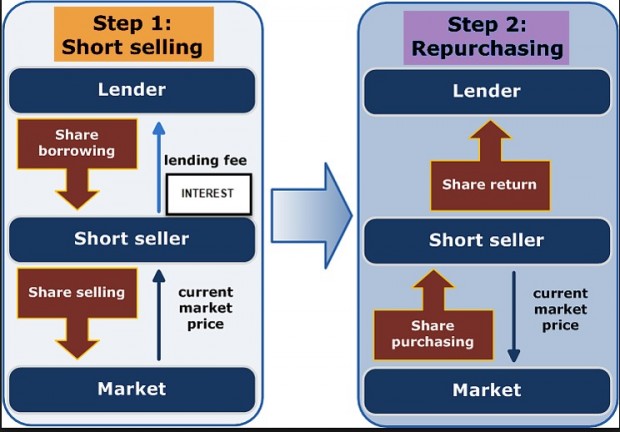Our approach to covered call writing and put-selling in bear markets include an arsenal of trading concepts that will enhance our opportunities for successful outcomes. These include:
- Use of deep in-the-money calls
- Use of deep out-of-the-money puts
- Use of lower implied volatility securities
- Use of low-beta stocks
- Use of exchange-traded funds
- Lowering our time value return goals during the bear market environment
- Use of appropriate position management bear-market techniques
- Use of inverse exchange-traded funds in confirmed bear markets
Some of our members have asked about shorting stocks as an alternative strategy during these bear markets and this article is dedicated to a discussion of this approach.
What is shorting a stock?
This when an investor sells a stock not currently owned and therefore needs to be borrowed before selling. The expectation is for the share value to decline so it can be repurchased at a lower price and therefore generate a profit. The stock is generally borrowed from a broker’s inventory and there will be a lending or interest fee. The short sale will result in a cash deposit into the investor’s account. Eventually the shares are re-purchased at market and returned to the lending broker. The profit or loss will be determined by the price the shares are repurchased. The chart below summarizes the process:

Short-selling a Stock
Note: Short-selling cannot be used with penny stocks and must be sold in round lots (100 share increments)
Why are there short-sellers?
Speculating: Investors speculating that there will be a share price decline
Hedging: Protecting long positions in the same vein that portfolio managers may aspire to achieve Delta-neutral portfolios… a long position is Delta-positive and a short position is Delta-negative
Risks
- Stock markets have upward bias…short-selling is like running uphill
- Losses are potentially unlimited (stock price can go as high as infinity) but gains are limited (stock price cannot go below zero). Use of buy stop-loss orders are critical
- May be exposed to margin call since borrowing shares mean margin trading. We may be required to add cash to our account or liquidate positions
- A short squeeze (short-sellers covering positions) can cause stock price to accelerate exponentially
- Short-sellers may be required to pay dividends to the stock lenders (best to short sell a stock that pays no dividends)
Discussion
Shorting a stock is a bear-market strategy that may be appropriate for some sophisticated investors with a high risk-tolerance. For most retail investors, in my humble opinion, there are better, less speculative, approaches to bear market scenarios which I enumerated in the first paragraph of this article.
Market tone
This week’s economic news of importance:
- Industrial production Dec 0.09% (above expectations)
- Weekly jobless claims for week ending 1/13 220,000 (below expectations)
- Housing starts Dec 1.192 million (below expectations)
- Building permits Dec 1.302 million
- Consumer sentiment Jan 94.4 (below expectations)
THE WEEK AHEAD
Mon Jan 22nd
- Chicago Fed national activity index Dec
Tue Jan 23rd
- None scheduled.
Wed Jan 24th
- Markit manufacturing PMI Jan
- Markit services PMI Jan
- Existing home sales Dec
Thu Jan 25th
- Weekly jobless claims for week ending 1/20/18
- New home sales Dec
- Leading economic indicators Dec
Fri Jan 26th
- GDP Q4
- Durable goods orders Dec
For the week, the S&P 500 rose by 0.86% for a year-to-date return of 5.11%
Summary
IBD: Market in confirmed uptrend
GMI: 6/6- Buy signal since market close of August 31, 2017
BCI: I have a short-term bullish approach to the market, selling 2 out-of-the-money strikes for every 1 in-the-money strike. The potential of a government shutdown may represent a short-term bum-in-the-road.
WHAT THE BROAD MARKET INDICATORS (S&P 500 AND VIX) ARE TELLING US
The 6-month charts point to a slightly bullish outlook. In the past six months, the S&P 500 was up 15% while the VIX (11.20) moved up by 15% but still historically low.
